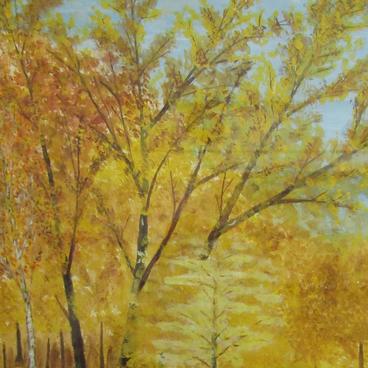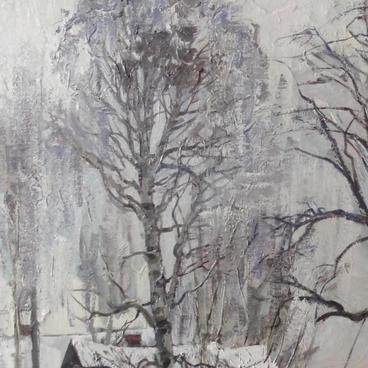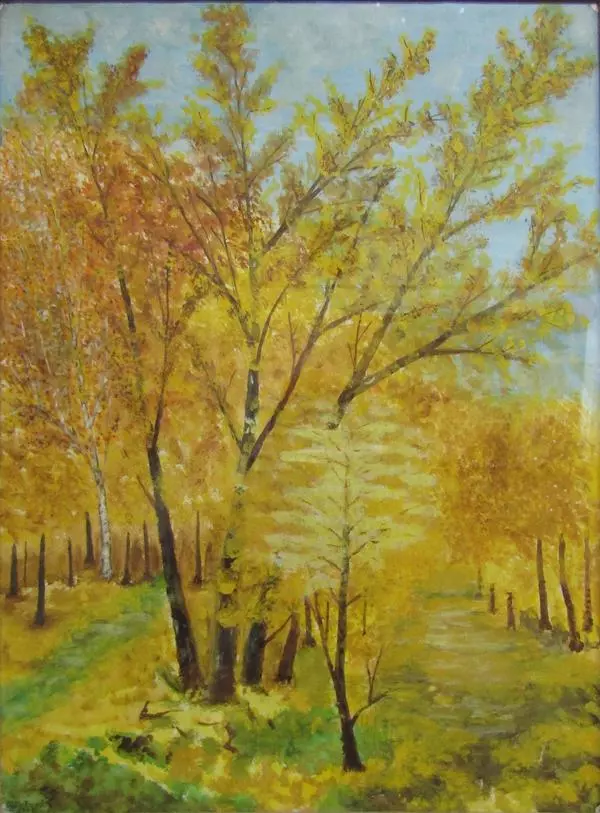The colour scheme of Ivan Rubtsov’s painting The Sea at Night consists of greenish-black shades. The viewer’s eye is immediately caught by the silvery moon that appears to be the main source of light in the painting. Thanks to its bright reflections the sky and the water look fascinating. The moonlit sea surface brings to view the silhouette of a boat. This striking painting attracts the viewer’s attention by the incredible depth of the canopy of heaven.
Ivan Rubtsov’s Sea at Night suggests some similarity with the Moonlit Night on the Dnieper by another famous artist Arkhip Kuindzhi, which is not incidental since Rubtsov drew inspiration from Kuindzhi’s painting while creating his own work. He succeeded in capturing the remarkable glittering of water and the sky in the fickle moonlight.
Ivan Rubtsov was born on 7 September 1923 in the village of Voyeykovo of the Tula Region, where he graduated from the secondary school and went on to serve in the army in 1940. He studied at the Stalingrad and Rustavskaya Military Aviation Schools.
From July 1943, he participated in the 1941–1945 Great Patriotic War as a pilot having flown 397 combat missions, mostly to cover attack bombers. Ivan Rubtsov fought in 75 air combats and personally shot down 12 enemy planes. He destroyed one more German aircraft as a pilot group member. Four enemy planes were burnt by him on the airfields.
When the war ended, he continued to serve in the army holding various positions up until 1973. On 11 September 1998, by his decree, the President of the Russian Federation awarded retired Colonel Ivan Rusbtsov, a resident of the Moscow Region’s Odintsovo, the honourary title of Hero of the Russian Federation.
A flying ace, PhD in Technical Sciences, Rubstov was a person of versatile talent: he composed poetry, published several collections of literary works and became a member of the Union of Writers of Russia. He played different musical instruments and composed music being a self-taught musician — he learnt musical notation, the art of writing and painting by himself.
Ivan Rubtsov started to paint rather late, at the age of sixty. By that time he had become a widower and tried to sooth his pain through art making. One of his first works was a pastel portrait of his wife. Later he used it as a model for a bronze sculpture. Ivan Rubtsov died on 7 March 2013. He is buried at the Kuntsevo Cemetery next to his wife.
Ivan Rubtsov’s Sea at Night suggests some similarity with the Moonlit Night on the Dnieper by another famous artist Arkhip Kuindzhi, which is not incidental since Rubtsov drew inspiration from Kuindzhi’s painting while creating his own work. He succeeded in capturing the remarkable glittering of water and the sky in the fickle moonlight.
Ivan Rubtsov was born on 7 September 1923 in the village of Voyeykovo of the Tula Region, where he graduated from the secondary school and went on to serve in the army in 1940. He studied at the Stalingrad and Rustavskaya Military Aviation Schools.
From July 1943, he participated in the 1941–1945 Great Patriotic War as a pilot having flown 397 combat missions, mostly to cover attack bombers. Ivan Rubtsov fought in 75 air combats and personally shot down 12 enemy planes. He destroyed one more German aircraft as a pilot group member. Four enemy planes were burnt by him on the airfields.
When the war ended, he continued to serve in the army holding various positions up until 1973. On 11 September 1998, by his decree, the President of the Russian Federation awarded retired Colonel Ivan Rusbtsov, a resident of the Moscow Region’s Odintsovo, the honourary title of Hero of the Russian Federation.
A flying ace, PhD in Technical Sciences, Rubstov was a person of versatile talent: he composed poetry, published several collections of literary works and became a member of the Union of Writers of Russia. He played different musical instruments and composed music being a self-taught musician — he learnt musical notation, the art of writing and painting by himself.
Ivan Rubtsov started to paint rather late, at the age of sixty. By that time he had become a widower and tried to sooth his pain through art making. One of his first works was a pastel portrait of his wife. Later he used it as a model for a bronze sculpture. Ivan Rubtsov died on 7 March 2013. He is buried at the Kuntsevo Cemetery next to his wife.




